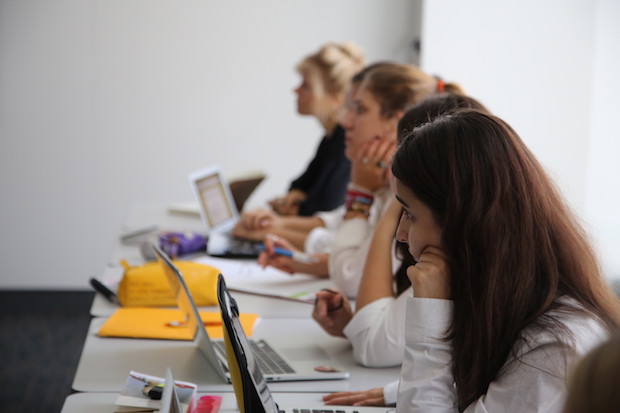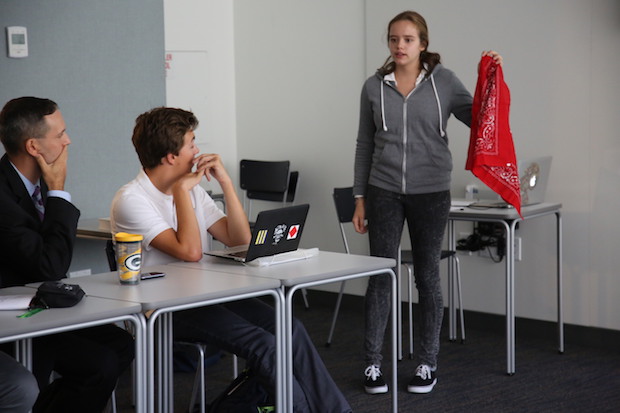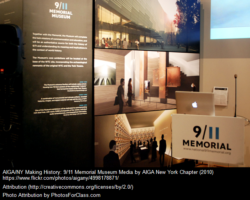In 2016, we commemorated the 15th anniversary of the attacks on September 11. These most lethal attacks on U.S. soil left scars in New York City, Arlington, Va., Shanksville, Pa. and in the hearts of all Americans.
Lea, an 11th-grade student, became a student ambassador at the 9/11 Memorial Museum during the past year and shared a presentation with 12th-grade students on Tuesday, September 13. Lea was in France and just one year old in 2011, but she says that she was personally interested in the events of 9/11 because her father was in New York City at the time. The tumultuous aftermath of the terrorist attacks delayed her family’s arrival in New York for four years, thus separating her from her father. Since moving to New York, she has been curious about those tragic events. She learned much about them from her father’s recollections, as he was in downtown Manhattan on that fateful day.
We invited Lea to speak to Mme Gibert’s 12th-grade history classes. They study the history of memories and the memorialization of historical events as part of the American section of the OIB curriculum, developed in France in collaboration with the College Board and US teachers. Students explore how history is remembered by various actors and how consensus is forged over time, even while memories may be contested by different groups. Students also investigate how institutions articulate an “official” way of commemorating significant historical events. In this context, Lea’s presentation addressed essential questions that historians grapple with: namely the intersection of the past with the present in the form of memory.
Lea explained that the 9/11 Memorial Museum is a relatively new institution, opening only two and half years ago. The Museum adopts the official version of the events of 9/11 as expressed in the “9/11 Commission Report,” to the US President and Congress, and shared with the American people in 2004. She identified the authors of the attacks and the fatal consequences of their actions in her presentation. She used the personal story of a man in a red bandana to bring the events to life for the students. He saved the lives of people he didn’t know by returning inside the WTC multiple times before the towers collapsed on him. (“Fighting to Live as the Towers Died,” New York Times, May 26, 2002.)

Relaying the official explanations, personal accounts, and a description of the memorial, Lea conveyed to students the multiple vectors through which history can be channeled into memories. She invited students to react to the events in their own manner, thus creating and sharing memories of their own.
Student excerpts:
“One point really stood out to me and caught my attention: the feeling of an experience is connected to the memory, it impacts how we recollect and remember it…This summer, I visited Cambodia, a country whose bloody history was marked by the occupation of the Khmers Rouge. Before going there, I did not know much about the situation, never having learned anything about Cambodia’s history in school. However, after I had a chance to visit several extermination camps and hear testimonies there, my vision completely changed. All of a sudden, that same history felt incredibly tangible. Hearing the music that was used to cover the screams of the victims, having seen the torture instruments that were used, hearing unbelievably touching testimonies… Every time I talk about it, I surprise myself

being brought back to these torturous memories filled with sadness. This experience definitely changed my way of re-telling and viewing the situation–a feeling many have experienced or experience still with their own vision of 9/11.” —Jeanne
“What is the role of this memorial? To mark the imprint of the event on the city and New Yorkers; to show the importance, the grandeur of the event and to remember it. The memorial tries to give those who visit it a sense of the event. With the 9/11 Memorial, the fountains remind us of the size of the towers, the void that now fills the space, the water falling in the center goes back to the idea of the towers crashing into the ground and bringing all the people with them. For the Memorial to the Murdered Jews of Europe in Berlin, the architecture helps us feel the sense of oppression with the continually growing gray stone blocks that make us feel smaller and smaller…” —Inès
“As far as I’m concerned, the 9/11 memorial is a form of legacy that reflects on the tragic attacks that targeted the World Trade Center on September 11, 2001. This memorial has for goal to honor the lives of the victims these attacks, and also to make tribute to the whole city of New York. Now, One World Trade Center symbolizes America’s strength and recovery from the 9/11 outrage.” —Fares
“The human aspect, the individual stories, bring us closer to the situation and help us to truly understand what it really means when there is an attack. It’s real. It’s not about ideologies, policies, or government. It’s about people.” —Lâlé
Returning to sixth grade
Lea also offered to teach an extra class: Ms. Kelly’s sixth-grade accelerated English class, as another follow up to her role as Ambassador at the 9/11 Memorial Museum. Lea was able to adapt her presentation to the younger students, consistently involving them by asking excellent questions and verifying their understanding of events. The students, who were not yet born when the tragic day occurred, learned a considerable amount of information about the events and consequences of September 11th, and most importantly, had the opportunity to discuss the meaning of those events as citizens in 2016. Lea came full cycle in her Ambassadorship, teaching the students of a class that she herself had sat in five years ago.
-With thanks to Carine Gibert, Mary Kelly, Lea and the students of TES2 for their participation.
About the Author :
Arthur Plaza holds a Ph.D in History and French Studies from New York University. He also studied at Sciences-Po and was awarded a Fulbright Fellowship to conduct research in France in 2004-2005. Part of his research was published in the collective volume entitled “Politiques de la laïcité au XXe siècle” (PUF, 2007). In addition, he has been an editorial assistant at the scholarly journal, French Politics, Culture & Society.

